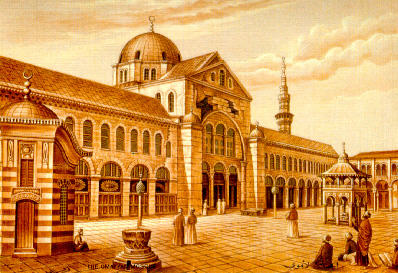
6- The Omayyad Mosque

This Great Mosque stands at the heart of the Old City at the end of Souq al-Hamidiyeh. It was built by the Omyyad Caliph al-Walid ibn Abdul Malek in 705 A.D. when Damascus was the capital of the Arab Islamic Empire.
It was constructed on the site of what has always been a place of worship: first, a temple for Hadad, the Aramean god of the ancient Syrians three thousand years ago; then, a pagan temple (the temple of Jupiter the Damas- cene) during the Roman era. It was later turned into a church called John the Baptist when Christianity spread in the fourth century. Following the Islamic conquest in 635, Muslims and Christians agreed to partition it between them, and they began to perform their rituals side by side.
When al-Walid decided to erect an impressive mosque suited to the grandeur of the Arab state 'whose like was never built before, nor will ever be built after' as he is reported to have said, he negotiated with the Christian community of Damascus, and undertook to construct a new church for them (St. John's) and allot several pieces of land for other churches, if they relinquished their right to their part of the Mosque. They agreed. It took ten years and eleven million gold dinars, as well as a huge number of masons, artists, builders, carpenters, marble-layers, and painters to complete. It became an architectural model for hundreds of mosques through- out the Islamic world.
A prominent feature of it are the three minarets built in different styles; the upper parts of which renovated during the Ayoubite, Mamluk, and Ottoman eras. The mosque has a large prayer hall and an enormous courtyard. The interior walls are covered with mosaic panels, made of coloured and gilded glass, portraying scenes from nature. The dome is greyish-blue, celebrated for its magnificence. The prayer hall contains a domed shrine venerated by both Christians and Muslims, the tomb of St. John the Baptist.
7- The Azem Palace
This also stands at the heart of the Old city, on the southern side of Omayyad Mosque, and very close to it. It is an astonishing example of a Damascene house, where the simple, almost primitive, exterior contrasts rather sharply with beauty and sophistication of the interior. Here one finds a sense od space, a wealth of polychrome stone, splendid marble, cascading fountains, and fragrant flowers. The palace was built in the mid-eighteenth century for the Governor of Damascus. The palace now houses the Museum of Arts and Popular Traditions.
8- The Damascus Citadel
The only fortress in Syria built on the same level as the city, it does not top a hill or a mountain like all other castles and citadels. It was erected by the Seljuks in 1078 A.D. with masonry taken from the city wall. and turned into a heavily-fortified citadel surrounded by walls, towers, a moat and trenches. Inside, they built houses, baths, mosques, and schools; it was a city within a city. At the height of Crusaders raids and attacks, was used as residence for the sultans of Egypt and Syria such as Nureddin, Saladin, and al-Malek al-adel, whence they supervised military operations against the Crusaders. But al-Malek al-Adel soon found that it was no longer adequate for defence against contemporary weapons and siege tactics, so he decided in 1202 to demolish and re-build it. The outcome was an impressive modern citadel, incorporating the latest inventions in the martial arts. It had imposing walls and a dozen colossal turrets surrounding it; there were three-hundred arrow slits and enormous parapets all round.
In the mid-thirteen century, however, it was the principal target for Tatar and Mongol attacks, and was later neglected by the Ottomans. The moats and trenches around it were filled up, and the souqs of Hamidiyeh, Asrounieh, and al-Khuja were built thereon. Recently, the latter was demolished, and the wetern walls of the fortress came into full view. Extensive repair and restoration work is underway at the moment; when completed the citadel will become a war museum, and a centre for various cultural activities.